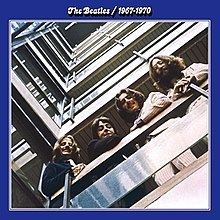Released 2 April 1973 Release date 2 April 1973 | Length 99:40 | |
 | ||
Genres Rock music, Psychedelic rock Similar The Beatles albums, Rock music albums | ||
1967–1970 (widely known as "The Blue Album") is a compilation of songs by the English rock band The Beatles, spanning the years indicated in the title. It was released with 1962–1966 ("The Red Album"), in 1973. 1967–1970 made number 1 on the American Billboard chart and number 2 on the British Album Chart. This album was re-released in September 1993 on CD, charting at number 4 in the United Kingdom.
Contents
The album was compiled by Beatles manager Allen Klein. Songs performed by the Beatles as solo artists were also considered for inclusion, but like the cover songs on 1962–1966, limited space resulted in this idea having to be abandoned. Along with its 1962–1966 counterpart, it compiles every single A-side released by the band in the UK.
As with 1962–1966, this compilation was produced by Apple/EMI at least partially in response to a bootleg collection titled Alpha Omega, which had been sold on television the previous year. Print advertising for the two records made a point of declaring them "the only authorized collection of the Beatles."
Album covers
For the group's 1963 debut LP Please Please Me, photographer Angus McBean took the distinctive colour photograph of the group looking down over the stairwell inside EMI House (EMI's London headquarters in Manchester Square, now demolished).
In 1969, the Beatles asked McBean to recreate this shot. Although a photograph from the 1969 photo shoot was originally intended for the then-planned Get Back album, it was not used when that project saw eventual release in 1970 as Let It Be. Instead, another photograph from the 1969 shoot, along with an unused photograph from the 1963 photo shoot, was used for both this LP and 1962–1966.
The inner gatefold photo for both LPs is by Don McCullin from the "Mad Day Out" photo session in London on Sunday 28 July 1968.
The album cover was designed by Tom Wilkes.
International versions
Unlike the 1962–1966 collection, the Blue Album was largely the same in the US and UK, although there were some variations.
The US edition had both "Penny Lane" and "Hello, Goodbye" in fake stereo, and "I Am the Walrus" with a four-beat electric piano introduction; the UK version had the more common six-beat beginning.
In the Spanish edition "One After 909" substituted "The Ballad of John and Yoko", a song that was banned from the airwaves shortly after being released as a single in 1969, for its allusion to "Christ" in the lyrics.
The albums had several other variants and anomalies. "Get Back" was described as the album version in the US liner notes, although it was in fact the single version. In both countries, "Hey Jude" was around nine seconds shorter than it had been on the original single, although the full length was restored for the 1993 compact disc edition.
The original vinyl version faded in during the crowd noise at the beginning of "A Day in the Life". The original compact disc edition, meanwhile, featured a clean version previously heard on the Imagine: John Lennon soundtrack album in 1988.
The album liner notes state that all songs were produced by George Martin, except "Across the Universe" and "The Long and Winding Road" produced by Phil Spector, meaning that George Martin was credited as producer of the song "Don't Let Me Down" which usually has no official producer's credit.
Release variations
Track listing
Certifications
In the US, the album sold 1,294,896 double LPs by December 31, 1973 and 3,850,026 double LPs by the end of the decade.
Songs
1Strawberry Fields Forever4:10
2Penny Lane3:04
3Sgt Pepper's Lonely Hearts Club Band2:02
